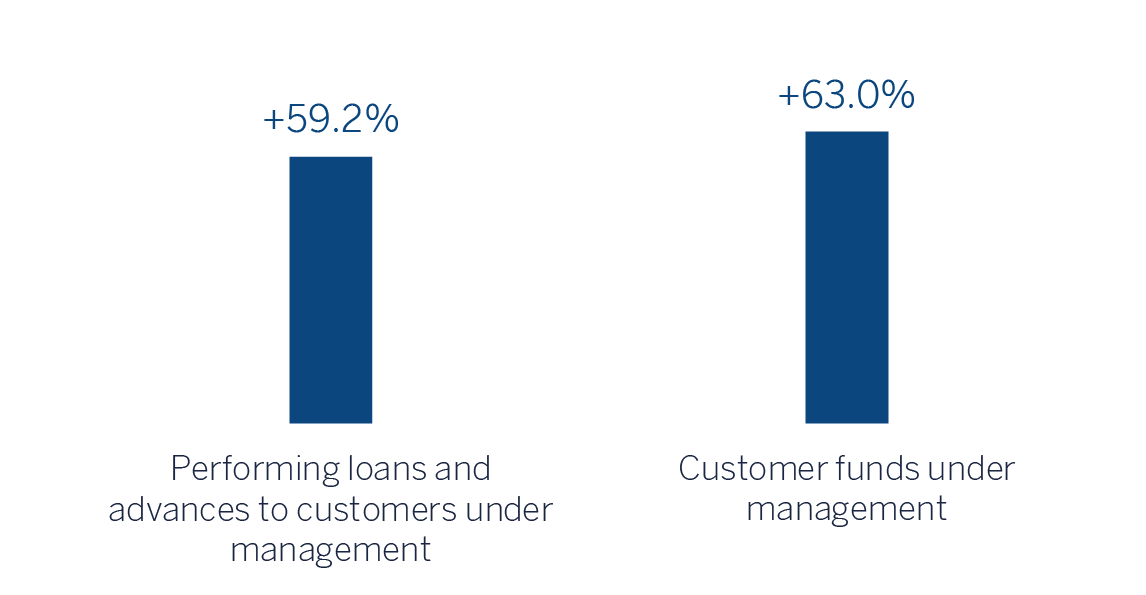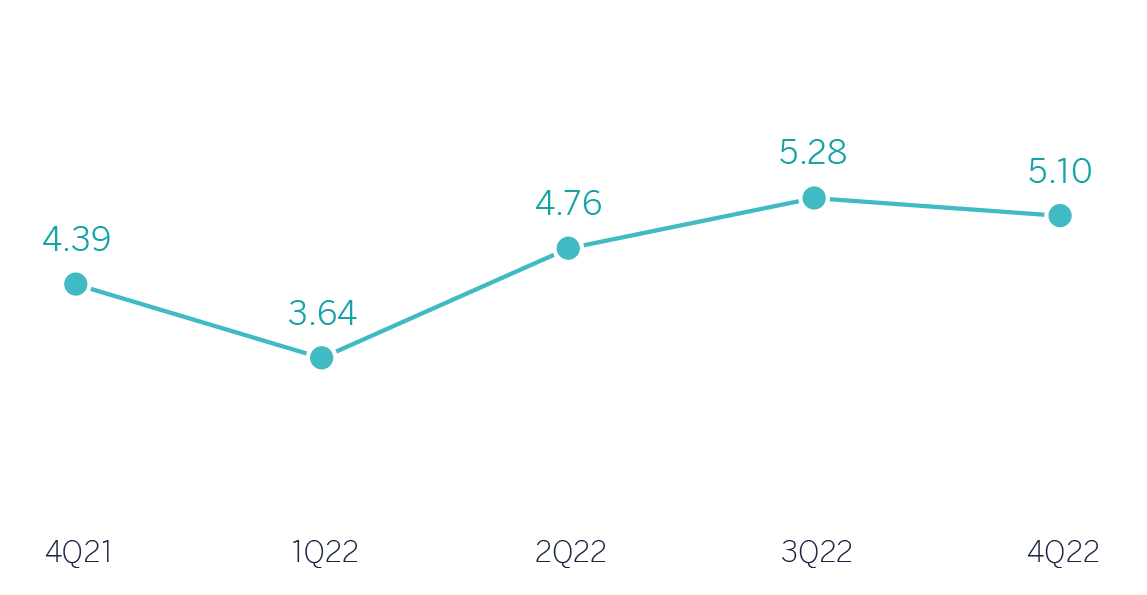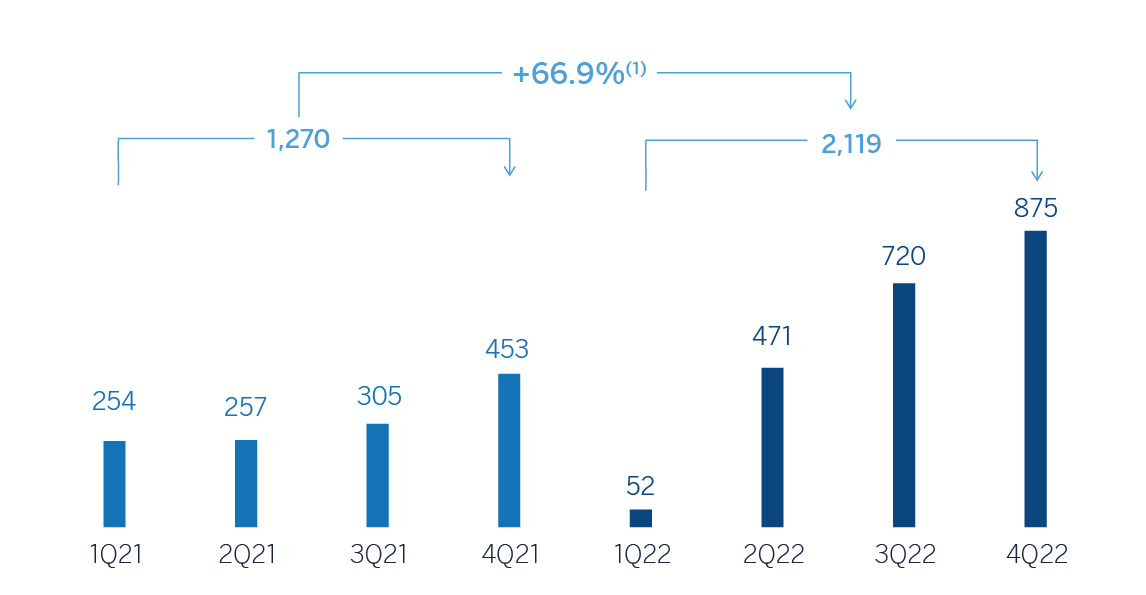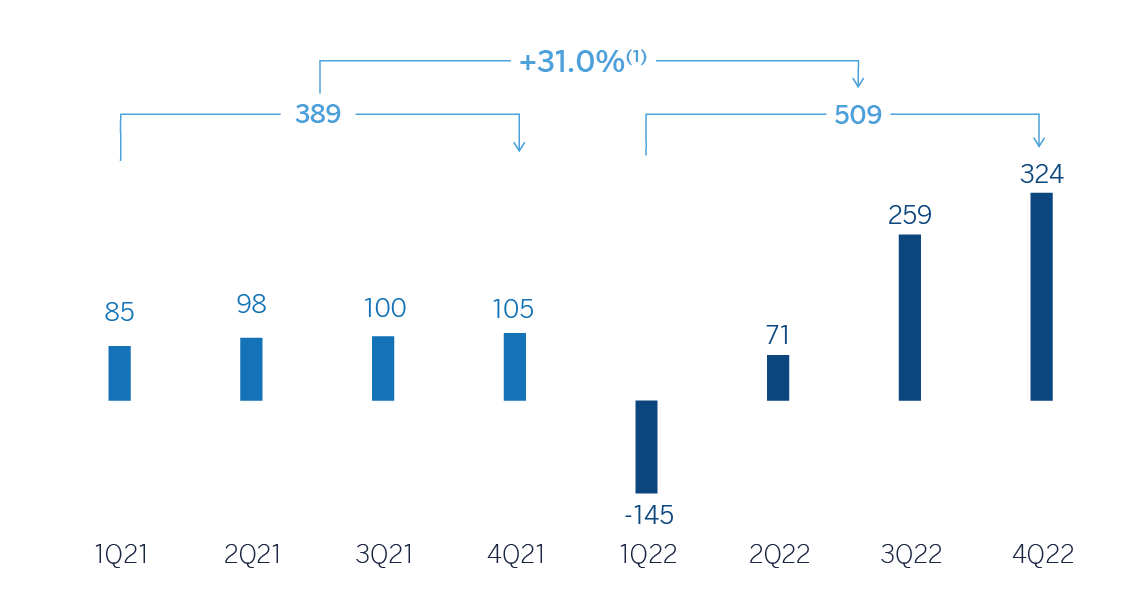Turkey
Highlights
- Acceleration of local currency portfolio and reduction of exposure to foreign currency portfolios
- Lower hyperinflation adjustment in the quarter
- Strength of risk indicators
- Quarterly growth in net attributable profit
Business activity (1)
(VARIATION AT CONSTANT EXCHANGE RATE COMPARED TO
31-12-21)

(1) Excluding repos.
Net interest income / AVERAGE TOTAL ASSETS
(Percentage at Constant exchange rate)

Operating income
(Millions of euros at constant exchange rate)

(1) At current exchange rate: -12.2%.
Net attributable profit (LOSS)
(Millions of euros at constant exchange rate)

(1) At current exchange rate: -31.0%.
Financial statements and relevant business indicators (Millions of euros and percentage)
| Income statement | 2022 | ∆% | ∆% (1) | 2021 (2) |
|---|---|---|---|---|
| Net interest income | 2,631 | 11.0 | 110.9 | 2,370 |
| Net fees and commissions | 587 | 4.0 | 97.5 | 564 |
| Net trading income | 741 | 79.4 | 240.9 | 413 |
| Other operating income and expenses | (774) | n.s. | n.s. | 74 |
| Gross income | 3,185 | (6.9) | 76.9 | 3,422 |
| Operating expenses | (1,067) | 5.6 | 100.7 | (1,010) |
| Personnel expenses | (593) | - | 90.0 | (593) |
| Other administrative expenses | (345) | 15.8 | 120.0 | (298) |
| Depreciation | (129) | 8.6 | 106.4 | (118) |
| Operating income | 2,119 | (12.2) | 66.9 | 2,412 |
| Impairment on financial assets not measured at fair value through profit or loss | (387) | (21.8) | 48.7 | (494) |
| Provisions or reversal of provisions and other results | (88) | n.s. | n.s. | 33 |
| Profit (loss) before tax | 1,644 | (15.8) | 60.1 | 1,952 |
| Income tax | (1,105) | 143.1 | n.s. | (455) |
| Profit (loss) for the period | 538 | (64.0) | (31.6) | 1,497 |
| Non-controlling interests | (29) | (96.2) | (92.7) | (758) |
| Net attributable profit (loss) | 509 | (31.0) | 31.0 | 739 |
- (1)At constant exchange rate.
- (2) Restated balances due to reallocation of some technology expenses. For more information, please refer to the “Business Areas” section.
| Balance sheets | 31-12-22 | ∆% | ∆% (1) | 31-12-21 |
|---|---|---|---|---|
| Cash, cash balances at central banks and other demand deposits | 6,061 | (21.9) | 2.3 | 7,764 |
| Financial assets designated at fair value | 5,203 | (1.6) | 28.9 | 5,289 |
| Of which: loans and advances | 3 | (99.0) | (98.7) | 295 |
| Financial assets at amortized cost | 51,621 | 24.3 | 62.9 | 41,544 |
| Of which: loans and advances to customers | 37,443 | 19.2 | 56.2 | 31,414 |
| Tangible assets | 1,213 | 94.6 | 155.0 | 623 |
| Other assets | 1,944 | 89.8 | 148.7 | 1,025 |
| Total assets/liabilities and equity | 66,043 | 17.4 | 53.9 | 56,245 |
| Financial liabilities held for trading and designated at fair value through profit or loss | 2,138 | (5.9) | 23.3 | 2,272 |
| Deposits from central banks and credit institutions | 2,872 | (29.7) | (7.9) | 4,087 |
| Deposits from customers | 46,339 | 20.9 | 58.4 | 38,341 |
| Debt certificates | 3,236 | (10.6) | 17.2 | 3,618 |
| Other liabilities | 4,748 | 119.2 | 187.3 | 2,166 |
| Regulatory capital allocated | 6,711 | 16.5 | 52.7 | 5,761 |
| Relevant business indicators | 31-12-22 | ∆% | ∆% (1) | 31-12-21 |
|---|---|---|---|---|
| Performing loans and advances to customers under management (2) | 37,191 | 21.5 | 59.2 | 30,610 |
| Non-performing loans | 2,597 | (13.3) | 13.7 | 2,995 |
| Customer deposits under management (2) | 45,592 | 18.9 | 55.9 | 38,335 |
| Off-balance sheet funds (3) | 6,936 | 78,1 | 133.4 | 3,895 |
| Risk-weighted assets | 56,275 | 13.2 | 48.3 | 49,718 |
| Efficiency ratio (%) | 33.5 | 29.5 | ||
| NPL ratio (%) | 5.1 | 7.1 | ||
| NPL coverage ratio (%) | 90 | 75 | ||
| Cost of risk (%) | 0.94 | 1.33 |
- (1) At constant exchange rate.
- (2) Excluding repos.
- (3) Includes mutual funds and pension funds.
Macro and industry trends
After surprising on the upside in the first half of the year, against a context of increasing fiscal and monetary stimulus, economic activity lost dynamism in the second half of the year. Thus, BBVA Research expects GDP growth in 2022 to be 5.5%, half a percentage point lower than forecast three months ago. The relative strength of demand, high commodity prices and the sharp depreciation of the Turkish lira in a context of negative interest rates in real terms (even more so after the interest rate cuts announced by the central bank) contributed to keeping inflation at particularly elevated levels (64.3% in December). According to BBVA Research estimates, growth could slow to 3.0% in 2023 (five tenths of a percentage point lower than the previous forecast), therefore reducing inflationary pressure and external accounts. However, the economic environment is highly unstable due to the combination of high inflation, very negative real interest rates, economic policy uncertainty, pressure on the Turkish lira, high external finance needs and the current global and regional context.
As for the Turkish banking industry, looking at data as of November 2022 in which the effect of inflation remains clear, the total volume of lending in the system increased by 54.1% year-on-year, a moderation compared to previous months. The stock of credit continued to be driven by the rise of consumer loans (+67.6% year-on-year) while credit to businesses grew slightly less (+53.4% year-on-year). Total deposits slowed down, especially demand deposits, after growing by 62.8% year-on-year in November 2022. The growth in Turkish lira deposits accelerated (+120.5%) while dollar deposits grew far more slowly (+30.0%), reducing dollarization to 47% by the end of 2022 (versus 65% at the end of 2021, boosted by the regulatory measures announced during the year to promote the growth of deposits in Turkish lira). As for the system's NPL ratio, it stood at 2.16% as of November 2022 (106 basis points lower than in the same month of 2021).
Unless expressly stated otherwise, all comments below on rates of changes for both activity and income, will be presented at constant exchange rates. For the conversion of these figures, the exchange rate as of December 31, 2022 is used. These rates, together with changes at current exchange rates, can be observed in the attached tables of the financial statements and relevant business indicators.
Activity
The most relevant aspects related to the area’s activity during the year 2022 were:
- Lending activity (performing loans under management) increased by 59.2% between January and December 2022, driven by the growth in Turkish lira loans (+79.5%). This growth was mainly supported by the performance of credit cards, commercial loans and, to a lesser extent, consumer loans. Regarding foreign currency loans (in U.S. dollars), the deleveraging continues (-16.3%).
- Customer deposits (70% of the area's total liabilities as of December 31, 2022) remained the main source of funding for the balance sheet and increased by 55.9%. Noteworthy is the positive performance of Turkish lira time deposits (+141.8%), which represent a 72.9% of total customer deposits in local currency, as well as demand deposits (+123.3%). Balances deposited in foreign currency (in U.S. dollars) continued their downward path and decreased by 22.8%, with transfers from foreign currency time deposits to Turkish lira time deposits observed under a foreign exchange protection scheme. For its part, off-balance sheet funds grew by 133.4%.
The most relevant evolution of the area's activity in the fourth quarter of 2022 has been:
- Lending activity was above the previous quarter (+12.4%), with a favorable evolution of the Turkish lira loans, highlighting credit cards (+30.4%) and consumer loans (+23.1%).
- In terms of asset quality, the NPL ratio decreased by 52 basis points compared to the rate reached at the end of September 2022 to 5.1%, due to the increase in loans in Turkish lira, together with a slight decline in NPL balance, where recoveries have offset new inflows. The NPL coverage ratio improved in the quarter to 90% as of December 31, 2022.
- Total funds under management showed a positive quarterly evolution (+9.9%), highlighting the growth of time deposits (+28.8%) and the dynamism of demand deposits (+25.6%), in local currency, as well as the growth of off-balance sheet funds (+37.5%).
Results
Turkey generated a net attributable profit of €509m in the year 2022. This result includes the impact of hyperinflation accounting in Turkey, with effect from January 1, 2022, which includes, among others, the loss of the net monetary position for a gross amount of €2,323m, partially offset by the gross impact of income from inflation-linked bonds (CPI linkers) of €1,490m, both recorded in the "Other operating income and expenses" line, as well as the impact of applying the period-end exchange rate as of December 31, 2022. These results are not comparable with those from the year 2021, as accounting for hyperinflation has been applied since January 1, 2022.
The most significant aspects of the quarterly evolution in the area's income statement were:
- Net interest income recorded a growth of 4.9% during the last quarter of the year, due to higher Turkish lira loan volumes, which offset the quarterly decline in customer spread.
- Net fees and commissions increased by 11.5%, mainly driven by the positive performance in payment systems, money transfers and brokerage activity.
- Income from NTI was slightly above the third quarter (+3.0%), mainly due to higher gains from currency positions and portfolio sales in the last quarter.
- Other operating income and expenses line includes, among others, the aforementioned loss in the value of the net monetary position due to the country's inflation rate, which was lower than that of the previous quarter. It should be noted that said loss is partially offset by the income derived from inflation-linked bonds (CPI linkers), which were higher in relation to those obtained in the third quarter of 2022.
- Operating expenses increased (+19.4%), mainly due to higher general expenses, highlighting the IT- related costs.
- Impairment on financial assets increased by 14.4%, mainly due to the deterioration of macroeconomic scenario. For its part, the accumulated cost of risk at the end of December 2022 recorded a slight increase to 0.94% from the 0.89% accumulated at the end of the previous quarter, but below the 1.33% registered at the end of the last year.
- The provisions and other results line closed December 2022 with a lower loss than the previous quarter, mainly due to the real estate revaluation in the last quarter.
